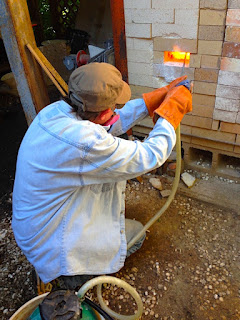Search This Blog
The adventures of Lori Buff, a studio potter and teacher, as she makes ceramic art and enjoys life with friends, family and some dogs. Travel and other interesting stuff is also discussed.
Featured
- Get link
- X
- Other Apps
Why Soda Firing
The pots in a soda kiln usually don’t have much glaze on the outsides of them, they are glazed by the introduction on soda ash, which volatiles when it hits the flame and creates a glaze. The flame then carries the soda ash through the kiln and the pots become glazed wherever the flame and soda kiss the pots.
Here you see me spraying the soda ash which is mixed with boiling water, into the kiln at about 2200 degrees.
The results can be greatly varied with this type of firing. For me, that's a big part of the fun of it. You never know with 100% certainty, what you will get from the kilns.
This pot shows where the glaze hit the surface and really added a nice difference in appearance. The green you see is a spearmint glaze that I used inside the pot and along the rim. The soda mixed with that glaze and made it very dark, almost black in some spots and almost white in others. You can also see where it kissed the shoulder of the vessel and the handles. The orange color is from a flashing slip which is used to help attract the soda and create a thermal history of where the flame caressed the pot. Also, it looks great.
The circles are from a wax resist that I brushed onto the surface of the pot before firing. I can explain more about that in another article.
Soda firing is called atmospheric firing because the artist uses the atmospheric in the kiln to help create the surface decoration of the pottery. Other forms of atmospheric firing are salt firing, wood firing, and reduction firing.
Check out the gallery page - Future Relics Gallery by Lori Buff
Here you see me spraying the soda ash which is mixed with boiling water, into the kiln at about 2200 degrees.
 |
| Spraying Soda in the Kiln |
This pot shows where the glaze hit the surface and really added a nice difference in appearance. The green you see is a spearmint glaze that I used inside the pot and along the rim. The soda mixed with that glaze and made it very dark, almost black in some spots and almost white in others. You can also see where it kissed the shoulder of the vessel and the handles. The orange color is from a flashing slip which is used to help attract the soda and create a thermal history of where the flame caressed the pot. Also, it looks great.
The circles are from a wax resist that I brushed onto the surface of the pot before firing. I can explain more about that in another article.
 |
| Soda Fired Pottery |
Check out the gallery page - Future Relics Gallery by Lori Buff
- Get link
- X
- Other Apps
Labels:
atmospheric firing
Functional ceramics
glazing ceramics
Pottery
soda fired pottery
soda firing
soda pots

Comments
Post a Comment